



After being in partnership with A G Thornton from 1878 at 8 Albert Square, Manchester, Joseph Halden set up his own firm at the same address when Thornton left. The firm were important manufacturers of both drawing and surveying instruments and had works at various addresses around Manchester with branches in many other cities. They were taken over by the Ozalid group in 1969.

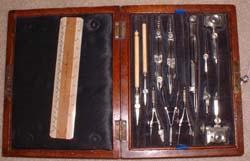
A mahogany boxed set of traditional pattern instruments, unusually having a set of beam compass fittings in place of the 6" compass half set usually found. The rule and pens are not original being by different makers. The set dates from 1925.
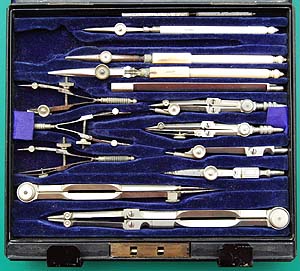
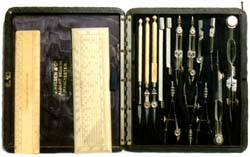
A top quality set of Halden traditional pattern instruments in a black (Russian) leather covered pocket case. These are small size instruments (4 1/2" compass etc.). The spring bows and bow compasses have Harling’s Improved Needle Points and the 4 1/2” compass has two extension bars. It dates from circa 1900. The spring bows and bow compasses would have been bought in from W H Harling. Possibly other instruments were as well.
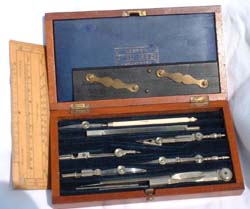
A traditional pattern set of student quality. The compass is missing its divider insert. The protractor is a "Pupils Own". Early twentieth century.
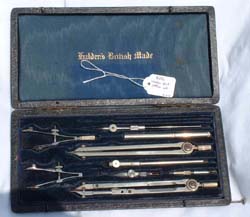
An early flat pattern (British Empire pattern) set by Halden. I also have a larger set with detail differences see below.
There is also a small set of very similar instruments stamped "Husun" (Henry Hughes & Son’s trade mark) in the collection.
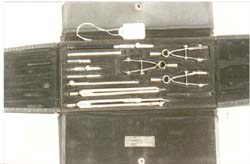
A Halden student quality set, mid C20, in a wallet case.
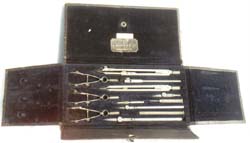
Another similar set of mid C20 instruments.
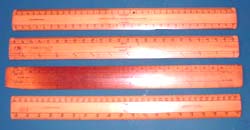
A selection of twelve inch boxwood scale rules. The top three are double sided and the lowest one is single sided. They have a wide variety of scales suitable for use by surveyors and architects.
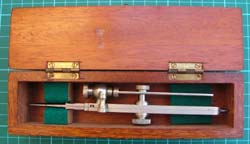
Halden 6 inch proportional divider with micrometer setting bar. The electrum instrument is housed in a mahogany box. It is fully divided for lines, circles, plans and solids. The bar is in the position where it can be used to accurately set the scale setting. It can be seen opened in the “Dividers” page.
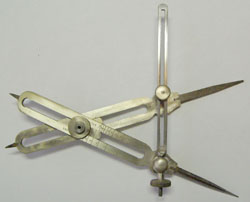
Another, slightly larger, Halden proportional divider, also made of electrum and fully divided. It is shown with the bar positioned for accurately setting the distance between the points. The setting bar on this instrument is steel whilst that on the previous one is electrum.
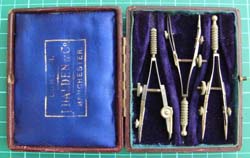
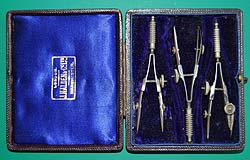
A second, similar set of three spring bows with type “B” points. These differ slightly in pattern from the set above and are probably a little later. All three are original to the set. Morocco leather covered case.

Halden Technical Premier 6125T set of flat pattern electrum instruments dating from about 1925 - 1930 in a wallet case. In the 1925 catalogue, Halden catalogued both the Premier and Technical Premier ranges in which the compasses, bows, spring bows and dividers were clearly the same design as Thornton’s Minerva and Techset ranges. I think that these instruments were made for Halden by Thornton who also supplied them to other firms.

Halden 1220 Vertical Drawing Compass. The parallel action is designed to keep both the point and the pen or pencil perpendicular to the paper. The compass is made of electrum. It is described as ‘new’ in the ca.1925 Halden catalogue. With both extension bars in place it was capable of drawing circles up to ten inches radius.
It has INNS PAT 359-10 stamped on one of the legs.
It has INNS PAT 359-
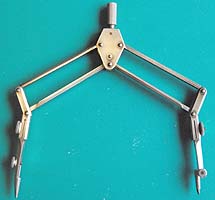
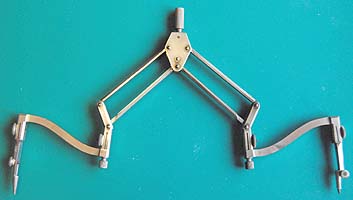
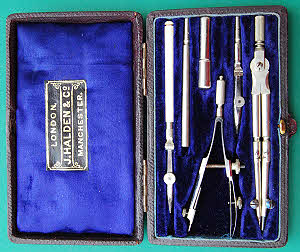
Round pattern set, probably dating from before the First World War. The instruments are of the pattern patented by Riefler and would probably have been imported from Germany.

12” ivory chain scale for 1/500 chains and equivalent feet signed J Halden & Co.


6” ivory and electrum sector signed Halden & Co Manchester & London
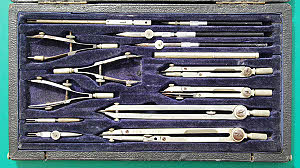
Halden British Empire pattern set, probably dating from ca.1920.

Six inch triangular boxwood chain scale, 10 & 20 on face 1, 30 & 40 on face 2 and 50 & 60 on face 3 chains/links to the inch.
| Early Sets |
| Traditional Sets |
| Later Sets |
| Major Makers |
| Instruments |
| Miscellanea |
| W F Stanley |
| A G Thornton |
| W H Harling |
| Elliott Bros |
| J Halden |
| Riefler |
| E O Richter |
| Kern, Aarau |
| Keuffel & Esser |
| Compasses |
| Pocket compasses |
| Beam compasses |
| Dividers |
| Proportional dividers |
| Pens |
| Pencils |
| Rules |
| Protractors |
| Squares |
| Parallels |
| Pantographs |
| Sectors |
| Planimeters |
| Map Measurers |
| Miscellaneous |
| Materials Used |
| Who made them |
| Who made these |
| Addiator |
| Addimult |
| Other German |
| USA |
| Miscellaneous |
| Microscopes |
| Barometers |
| Hydrometers & Scales |
| Pedometers |
| Surveying Instruments |
| Other instruments |
| Workshop Measuring Tools |
| Catalogues & Brochures |
| Levels & Theodolites |
| Compasses & Clinometers |
| Miscellaneous surveying |
| Micrometers & Verniers |
| Engineering rules and gauges |
| Wood rules & calipers |
| Dial gauges & miscellaneous |